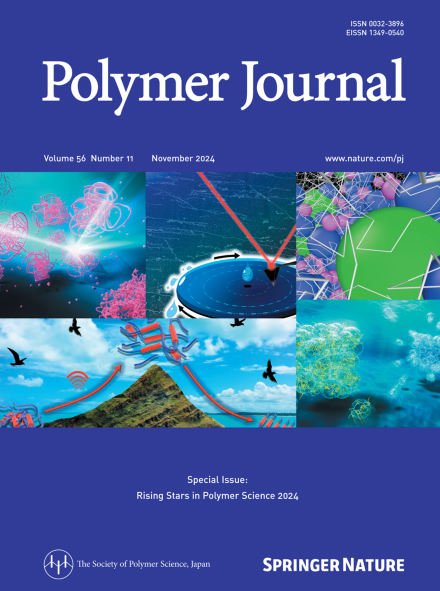Brownian simulations for fracture of star polymer phantom networks
IF 2.3
4区 化学
Q3 POLYMER SCIENCE
引用次数: 0
Abstract
According to a recent simulation study [Masubuchi et al., Macromolecules, 56, 9359 (2023)], the cycle rank plays a significant role in determining the fracture characteristics of network polymers. However, the previous studies considered only energy-minimized networks without including the effects of thermal agitation. To address this gap, this study conducted Brownian dynamics simulations at various stretch rates. The results showed that even with Brownian motion, the strain and stress at break obtained for different node functionalities and conversion ratios exhibited master curves when plotted versus the cycle rank. These master curves depend on the strain rate, indicating that the strain and stress at break decrease with decreasing strain rate. The curves are qualitatively similar to those observed in energy-minimized simulations, even though the competition among Brownian motion, elongation, and bond scission affects the fracture process. This study examined the fracture of polymer networks via Brownian simulations with various strain rates. The networks were created from star polymers with different branching degrees and conversion ratios. The results showed that strain and stress at break, plotted against cycle rank, form master curves dependent on strain rate; the fracture characteristics decrease with decreasing strain rate. Despite the interplay of Brownian motion, elongation, and bond scission, the cycle rank dependence is qualitatively similar to that reported previously for energy-minimized networks.

星形聚合物幻影网络断裂的布朗模拟
根据最近的一项模拟研究[Masubuchi et al., Macromolecules, 56, 9359(2023)],循环等级在决定网状聚合物的断裂特性方面起着重要作用。然而,以前的研究只考虑了能量最小化的网络,而没有考虑热搅拌的影响。为了解决这一差距,本研究在不同拉伸率下进行了布朗动力学模拟。结果表明,即使在布朗运动条件下,不同节点函数和转换率下的断裂应变和应力随循环阶的变化均呈现主曲线。这些主曲线与应变速率有关,表明断裂时的应变和应力随应变速率的减小而减小。尽管布朗运动、伸长率和键断之间的竞争影响了断裂过程,但这些曲线在质量上与能量最小化模拟中观察到的曲线相似。本研究通过布朗模拟研究了不同应变速率下聚合物网络的断裂。这些网络是由具有不同分支度和转化率的星形聚合物形成的。结果表明:断裂时的应变和应力随应变率的变化形成主曲线;断裂特征随应变速率的减小而减小。尽管存在布朗运动、延伸和键断裂的相互作用,但循环等级依赖在性质上与之前报道的能量最小化网络相似。
本文章由计算机程序翻译,如有差异,请以英文原文为准。
求助全文
约1分钟内获得全文
求助全文
来源期刊

Polymer Journal
化学-高分子科学
CiteScore
5.60
自引率
7.10%
发文量
131
审稿时长
2.5 months
期刊介绍:
Polymer Journal promotes research from all aspects of polymer science from anywhere in the world and aims to provide an integrated platform for scientific communication that assists the advancement of polymer science and related fields. The journal publishes Original Articles, Notes, Short Communications and Reviews.
Subject areas and topics of particular interest within the journal''s scope include, but are not limited to, those listed below:
Polymer synthesis and reactions
Polymer structures
Physical properties of polymers
Polymer surface and interfaces
Functional polymers
Supramolecular polymers
Self-assembled materials
Biopolymers and bio-related polymer materials
Polymer engineering.
 求助内容:
求助内容: 应助结果提醒方式:
应助结果提醒方式:


